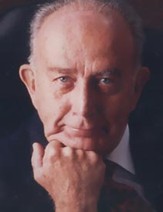William Donald Schaefer Statue
Introduction
Text-to-speech Audio
William Donald Schaefer (1921-2011) was a dominant and controversial force in local and state politics for over fifty years, serving as Baltimore mayor from 1971-1987 and as Maryland governor from 1987-1995. He was also the comptroller of Maryland from 1999-2007. A lifelong Democrat, Schaefer won every election he ran in except his reelection bid to be comptroller. He was credited for overseeing Baltimore's revitalization during his time as mayor but was also criticized by some for his leadership style and priorities which to some seemed more focused on economic development than reducing poverty and crime. This statue of Schaefer on the Baltimore waterfront was erected in 2009, two years before his death.
Images
The William Donald Schaefer (1921-2011) statue is located on the Baltimore waterfront and was erected in 2009.
.jpg)
William Donald Schaefer (1921-2011) served four terms as mayor of Baltimore and two terms as Maryland governor.

Backstory and Context
Text-to-speech Audio
Schaefer was born on November 2, 1921 in Baltimore to Baptist parents. He grew up in the Edmondson Avenue neighborhood. As a young man, he earned an undergraduate law degree in 1942 and a master of law degree in 1954, both from the University of Baltimore. During World War II, he joined the U.S. Army and became an officer. However, he did not see combat but managed army hospitals in Europe. When he returned to Baltimore he became a member of local housing and city planning organizations (he remained in the U.S. Army Reserves and retired in 1979 as a Colonel). His foray into politics was sparked when, around 1950, a local church lost a property in a corrupt auction. Upset at the situation, Schaefer unsuccessfully ran for the state legislature that year and in 1954. He did win a seat on the Baltimore City Council in 1955 and became its president in 1967.
Schaefer took his role as mayor very seriously during his four consecutive terms. He was known for riding around the city in a plain police car to take notes about problems or violations he saw and then requesting they be addressed immediately. By the time he became mayor, much of the old parts of the city were in bad shape with row houses and warehouses that had fallen into disrepair. To help get rid of the blight, he sold around 500 abandoned buildings for just $1 and hundreds of commercial buildings for $100. He initiated a number of development projects, including the construction of the waterfront on the inner harbor, a shopping center (located at the waterfront) known as Harborplace, new expressways, parks, the National Aquarium, a new convention center, and the World Trade Center designed by famed architect I.M. Pei. In 1984, he appointed Bishop L. Robinson as the city's first African American police commissioner. Schaefer also established community theaters and summer festivals, and led the effort (during his final years as mayor and then as governor) to build Camden Yards, where the Orioles baseball team plays, and M&T Bank Stadium, the home of the Baltimore Ravens football team.
As governor, Schaefer tackled unemployment, education, social programs, encouraged businesses (including overseas companies) to invest in the city, and cleaned up Chesapeake Bay. He also led the effort to a build light rail line from Timonium in Baltimore County through Baltimore to Cromwell Station/Glen Burnie in Anne Arundel County. An extension connects the city to Baltimore-Washinton International Airport. One controversial decision he made was commuting the sentences of eight abused women who killed or assaulted their partners. He also said that women on welfare should be given contraceptives and men being released from prison should get vasectomies.
A few years after leaving office, Schaefer was appointed Comptroller of Maryland (the state's chief financial officer) in 1999 and served until 2007. He then moved into a retirement home in Catonsville, Maryland where he remained until his death in 2011 at the age of 89. He received numerous awards and accolades during this career including the Greatest Public Service by an Elected Official from the Jefferson Awards Foundation, and the Distinguished Public Service Award from Brandeis University.
Sources
Cassie, Ron. "He Did It Now." Baltimore Magazine. December 2018. https://www.baltimoremagazine.com/section/historypolitics/william-donald-schaefer-personified-baltimore-everyman.
Gunts, Edward. "Schaefer statue makes him one with the people." The Baltimore Sun. October 30, 2009. https://www.baltimoresun.com/entertainment/arts/bal-schaefer-1030-story.html.
"Light Rail." Maryland Manual On-Line. https://msa.maryland.gov/msa/mdmanual/01glance/html/trans.html#light.
Marbella, Jean. "One last road trip for Schaefer." The Baltimore Sun. April 21, 2011. https://www.baltimoresun.com/maryland/bs-xpm-2011-04-22-bs-md-schaefer-route-20110421-story.html.
Martin, Sandra Olivetti. "William Donald Schaefer Maryland’s Legendary Mayor, Governor and Taxman." Bay Weekly. April 2006. https://bayweekly.com/old-site/year06/issuexiv14/leadxiv14_1.html.
McFadden, Robert D. "William Schaefer, Baltimore Mayor, Dies at 89." The New York Times. April 18, 2011. https://www.nytimes.com/2011/04/19/us/19schaefer.html?partner=rss&emc=rss.
"William Donald Schaefer (1921-2011)." Maryland Manual On-Line. March 14, 2022. https://msa.maryland.gov/msa/mdmanual/08conoff/comptroller/former/html/msa01489.html.
Wikimedia Commons: https://commons.wikimedia.org/wiki/File:Governor_Schaefer%27s_Birthday_(51650993748).jpg
